Open Creative Spaces
A creative space is a virtual or physical space in which people (students, educators, parents & community members) can collaborate with others to design, create, and build using physical materials and digital devices. It is informed and inspired by the Art Hives, Maker movement, and by the act of creation that makes us human.
Creative spaces focus on the process of making which allows individuals to make deep connections between concepts, solve real-world problems, develop perseverance, and/or simply create serendipitously.
A Creative Space brings together head, heart and hands.
Additional resources
- coding and programming
- microcontrollers
- robotics
- constructing with cardboard (Low-Tech. STEAM Challenges)
- working with e-textiles and paper circuits (e-textiles STEAM Challenges)
- designing and creating simple machines.
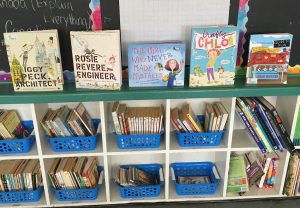 One of the most important roles for teachers in a creative space is to plan learning activities, projects or challenges that allow students room to explore, engage, and evaluate their own learning process through the act of making. Since there is an emphasis on process, there must be time to work on and store projects, a wide choice of materials, and lots of room for mistakes and Ah-Ha! moments.
One of the most important roles for teachers in a creative space is to plan learning activities, projects or challenges that allow students room to explore, engage, and evaluate their own learning process through the act of making. Since there is an emphasis on process, there must be time to work on and store projects, a wide choice of materials, and lots of room for mistakes and Ah-Ha! moments.Creative spaces provide a context for lifelong learning, interdisciplinarity, the development of essential skills, and real-world problem-solving. These include the Cross-Curricular Competencies from the Quebec Education Program:
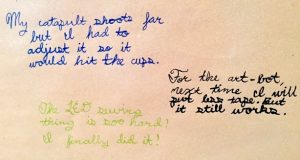
– Uses information
– Solves problems
– Exercises critical judgment
– Uses creativity
– Adopts effective work methods
– Uses ICT
– Achieves his/her potential
– Cooperates with others
– Communicates appropriately
– Using open-ended interdisciplinary challenges as a starting point to learn about a concept, tool, or technology and then taking it further;
– Trying out or remixing existing project examples in order to learn about a concept and to later build on it;
– Exploring different materials and techniques to become familiar with how they work and be inspired to invent and create something new;
– Starting with a specific idea and prototyping with a variety of materials to see what works best for your creation;
– Repurposing and creative reuse – taking objects apart or using recycled materials to make something new;
– Using the opportunity to meet a need at the school by building benches, gardening bins, bat and bird houses, or meet a need in your community;
– Trying to fix something that is broken or mending something that is worn out.
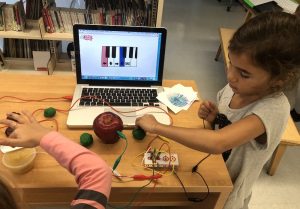
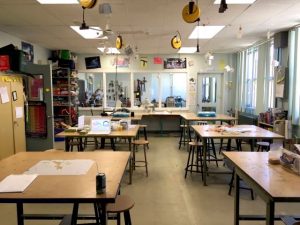 Your space can take many different forms – in fact, no two creative spaces look alike. The physical space can be in a classroom, a library, a designated space in the school, a set of bins in a common area or even a mobile supply cart that you roll into your classroom. It is not just about the physical space, but what will take place in your creative space and the mindset you want to encourage. If many age levels will be sharing the space, you’ll need to consider making a range of work surfaces and tools available.
Your space can take many different forms – in fact, no two creative spaces look alike. The physical space can be in a classroom, a library, a designated space in the school, a set of bins in a common area or even a mobile supply cart that you roll into your classroom. It is not just about the physical space, but what will take place in your creative space and the mindset you want to encourage. If many age levels will be sharing the space, you’ll need to consider making a range of work surfaces and tools available.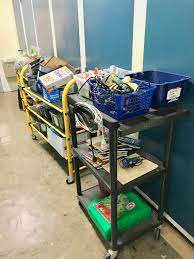 The list of available technologies may seem daunting, but your school may have already purchased equipment through the funding that was made available through different measures. When looking to invest in a creative space, you can start with what you have and what you know. The materials and tools are simply a means to an end. It is highly recommended that the school community be involved making choices about what to put in the space to meet local needs. Survey fellow teachers, students, and community members about their interests. As a staff, talk about what is happening in the classrooms, and how the creative space might augment the projects, activities, and challenges that are already in the works.
The list of available technologies may seem daunting, but your school may have already purchased equipment through the funding that was made available through different measures. When looking to invest in a creative space, you can start with what you have and what you know. The materials and tools are simply a means to an end. It is highly recommended that the school community be involved making choices about what to put in the space to meet local needs. Survey fellow teachers, students, and community members about their interests. As a staff, talk about what is happening in the classrooms, and how the creative space might augment the projects, activities, and challenges that are already in the works.
Think about the expression “low floor, high ceiling” – that is, tools that are fairly accessible and easy to start using but which have the potential to expand into larger, more complex projects. You don’t have to know everything to get started. Start small and let it grow. A first step might be to produce a list of consumables for parents to donate to the space. As the space develops, so will the tools. All you really need is cardboard, duct tape and an open mind. Allow for time for students and teachers to begin experimenting with the materials and tools in the space regardless of their familiarity.
- Consult members of your school community – staff, students, parents, local experts
- Get support from your School Board’s local RÉCIT consultants
- Community Partners, ie. Kids Code Jeunesse
- Provincial Conferences ie. QPAT, LCEEQ, CCI
- RemixEd Camp
- Training modules on the Campus RÉCIT site (in French)
- Training modules on the CADRE 21 site (in French)
- Online resources for specific tools and technologies
Pedagogy
- What are my pedagogical intentions and goals?
- What do I want students to learn and be able to do?
- What subject-specific and cross-curricular competencies do I want students to develop in the creative space?
- What activities and projects will support their learning?
Learning Environment
- What kind of learning environment do we want to create for our students?
- Are we giving them choice in the type of activities and the materials that they will use?
- Are we setting up the space to foster collaboration?
- Are we allowing time for ongoing projects?
Space and Material Management
- Who will have access to the space and/or materials?
- Who will be responsible for the management of the space and materials?
- Who will decide on purchases?
- Who will purchase consumables?
- How will we schedule time?
- Will we embed the creative space into our school timetable?
- Who will be responsible for the space?
- How will the community get involved?
- Who will make community connections?
Digital Devices
- What digital devices will best support our learning in the creative space?
- How can different technologies and materials be used to accomplish our goals?
- How will we make time for teachers and students to experiment with the tools and materials?
For more information about creative spaces, the design process, and the MAKER movement:
Professional Development:
Have you been to one of our workshops and would like to have more support?
Fill out our questionnaire and we will RSVP with ways that we can work together – all free of charge!
Professional Development Request Form
Or Contact: creativespaces@learnquebec.ca










